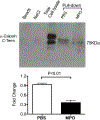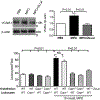Mechanistic Role of the Calcium-Dependent Protease Calpain in the Endothelial Dysfunction Induced by MPO (Myeloperoxidase)
- PMID: 29507101
- PMCID: PMC6467284
- DOI: 10.1161/HYPERTENSIONAHA.117.10305
Mechanistic Role of the Calcium-Dependent Protease Calpain in the Endothelial Dysfunction Induced by MPO (Myeloperoxidase)
Abstract
MPO (myeloperoxidase) is a peroxidase enzyme secreted by activated leukocytes that plays a pathogenic role in cardiovascular disease, mainly by initiating endothelial dysfunction. The molecular mechanisms of the endothelial damaging action of MPO remain though largely elusive. Calpain is a calcium-dependent protease expressed in the vascular wall. Activation of calpains has been implicated in inflammatory disorders of the vasculature. Using endothelial cells and genetically modified mice, this study identifies the µ-calpain isoform as novel downstream signaling target of MPO in endothelial dysfunction. Mouse lung microvascular endothelial cells were stimulated with 10 nmol/L MPO for 180 minutes. MPO denitrosylated µ-calpain C-terminus domain, and time dependently activated µ-calpain, but not the m-calpain isoform. MPO also reduced Thr172 AMPK (AMP-activated protein kinase) and Ser1177 eNOS (endothelial nitric oxide synthase) phosphorylation via upregulation of PP2A (protein phosphatase 2) expression. At the functional level, MPO increased endothelial VCAM-1 (vascular cell adhesion molecule 1) abundance and the adhesion of leukocytes to the mouse aorta. In MPO-treated endothelial cells, pharmacological inhibition of calpain activity attenuated expression of VCAM-1 and PP2A, and restored Thr172 AMPK and Ser1177 eNOS phosphorylation. Compared with wild-type mice, µ-calpain deficient mice experienced reduced leukocyte adhesion to the aortic endothelium in response to MPO. Our data first establish a role for calpain in the endothelial dysfunction and vascular inflammation of MPO. The MPO/calpain/PP2A signaling pathway may provide novel pharmacological targets for the treatment of inflammatory vascular disorders.
Keywords: calpain; cell adhesion molecules; endothelial cells; inflammation; peroxidase.
© 2018 American Heart Association, Inc.
Figures






Comment in
-
Calpain: A Novel Mediator of MPO (Myeloperoxidase)-Induced Endothelial Dysfunction.Hypertension. 2018 Apr;71(4):574-576. doi: 10.1161/HYPERTENSIONAHA.118.10441. Hypertension. 2018. PMID: 29507102 No abstract available.
Similar articles
-
Endothelial-transcytosed myeloperoxidase activates endothelial nitric oxide synthase via a phospholipase C-dependent calcium signaling pathway.Free Radic Biol Med. 2021 Apr;166:255-264. doi: 10.1016/j.freeradbiomed.2020.12.448. Epub 2021 Feb 1. Free Radic Biol Med. 2021. PMID: 33539947 Free PMC article.
-
Targeted subendothelial matrix oxidation by myeloperoxidase triggers myosin II-dependent de-adhesion and alters signaling in endothelial cells.Free Radic Biol Med. 2012 Dec 15;53(12):2344-56. doi: 10.1016/j.freeradbiomed.2012.10.002. Epub 2012 Oct 9. Free Radic Biol Med. 2012. PMID: 23059132 Free PMC article.
-
Protein kinase C upregulates intercellular adhesion molecule-1 and leukocyte-endothelium interactions in hyperglycemia via activation of endothelial expressed calpain.Arterioscler Thromb Vasc Biol. 2011 Feb;31(2):289-96. doi: 10.1161/ATVBAHA.110.217901. Epub 2010 Nov 11. Arterioscler Thromb Vasc Biol. 2011. PMID: 21071702 Free PMC article.
-
Dysregulation of Calpain Proteolytic Systems Underlies Degenerative Vascular Disorders.J Atheroscler Thromb. 2018 Jan 1;25(1):1-15. doi: 10.5551/jat.RV17008. Epub 2017 Aug 17. J Atheroscler Thromb. 2018. PMID: 28819082 Free PMC article. Review.
-
Myeloperoxidase: A versatile mediator of endothelial dysfunction and therapeutic target during cardiovascular disease.Pharmacol Ther. 2021 May;221:107711. doi: 10.1016/j.pharmthera.2020.107711. Epub 2020 Oct 31. Pharmacol Ther. 2021. PMID: 33137376 Review.
Cited by
-
Photoreceptor Cell Calcium Dysregulation and Calpain Activation Promote Pathogenic Photoreceptor Oxidative Stress and Inflammation in Prodromal Diabetic Retinopathy.Am J Pathol. 2021 Oct;191(10):1805-1821. doi: 10.1016/j.ajpath.2021.06.006. Epub 2021 Jun 29. Am J Pathol. 2021. PMID: 34214506 Free PMC article.
-
Dietary salt, vascular dysfunction, and cognitive impairment.Cardiovasc Res. 2025 Apr 8;120(18):2349-2359. doi: 10.1093/cvr/cvae229. Cardiovasc Res. 2025. PMID: 39429024 Review.
-
The Role of Neutrophil Extracellular Traps in Atherosclerosis: From the Molecular to the Clinical Level.J Inflamm Res. 2025 Mar 26;18:4421-4433. doi: 10.2147/JIR.S507330. eCollection 2025. J Inflamm Res. 2025. PMID: 40162077 Free PMC article. Review.
-
SARS-CoV-2 Spike triggers barrier dysfunction and vascular leak via integrins and TGF-β signaling.bioRxiv [Preprint]. 2021 Dec 13:2021.12.10.472112. doi: 10.1101/2021.12.10.472112. bioRxiv. 2021. Update in: Nat Commun. 2022 Dec 9;13(1):7630. doi: 10.1038/s41467-022-34910-5. PMID: 34931188 Free PMC article. Updated. Preprint.
-
Ginsenoside Rg1 ameliorates chronic intermittent hypoxia-induced vascular endothelial dysfunction by suppressing the formation of mitochondrial reactive oxygen species through the calpain-1 pathway.J Ginseng Res. 2023 Jan;47(1):144-154. doi: 10.1016/j.jgr.2022.07.006. Epub 2022 Jul 31. J Ginseng Res. 2023. PMID: 36644390 Free PMC article.
References
-
- Haumer M, Amighi J, Exner M, Mlekusch W, Sabeti S, Schlager O, Schwarzinger I, Wagner O, Minar E and Schillinger M. Association of neutrophils and future cardiovascular events in patients with peripheral artery disease. Journal of vascular surgery. 2005;41:610–7. - PubMed
-
- Lee CD, Folsom AR, Nieto FJ, Chambless LE, Shahar E and Wolfe DA. White blood cell count and incidence of coronary heart disease and ischemic stroke and mortality from cardiovascular disease in African-American and White men and women: atherosclerosis risk in communities study. American journal of epidemiology. 2001;154:758–64. - PubMed
Publication types
MeSH terms
Substances
Grants and funding
LinkOut - more resources
Full Text Sources
Other Literature Sources
Medical
Molecular Biology Databases
Research Materials
Miscellaneous

